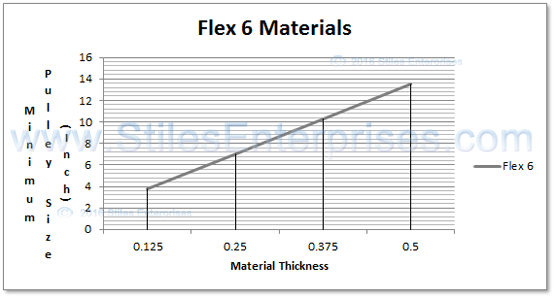|
||
|
We Work With The Best Manufactures To Give You The Best Solutions |
The Chart Below Is A Guideline To Establish A Starting Point Referencing The Flexibility of Cover Materials To Minimum Pulley Sizes. If the base belt requires a larger pulley than required for the cover, use the larger size. Depending on the material and the type of splice, spliced covers generally require larger pulleys than seamless covers.
It is hard to isolate the reasons for belt failure from belt movement around the pulleys. When traveling around pulleys, the outer surface of thicker belts has increased localized surface stress due to the increased distance that must be accommodated relative to the pitch length of the base belt. This can cause stress cracking, delamination or belt failure. Belt life can often be extended with larger pulleys, thinner base belts, thinner covers, or cross cutting the cover. Excessive flexing at the pulleys causes a heat build up which can contribute to reasons for belt failure.
Most Belt Manufacturers Will Not Give A Minimum Pulley Size Guideline because of the many variables which may affect the pulley and belt relationship. For the same reasons we can only offer this chart as a reference guide. When choosing a pulley size it is better for belt life to use larger diameters when possible. If there is the possibility that a less flexible cover material or increased thickness may be required, plan on using larger pulleys when designing the equipment. Belt speed, belt tension and surface abrasion can affect belt life. These problems can be exaggerated if pulleys are not in alignment, or if clearances are not accounted for.
We Do Not Represent This Chart As Any Form Of Belt Performance Warranty, but only as a basic starting guide in finding the right combination for your application.
Criteria For Belt Success / Failure Varies By Application And By The Customer. One application may define a belt's success if it lasts 1 day, while expected success criteria for another application may be one year or longer. For some customers a belt has not failed if it can still do the job. For other applications even the slightest amount of surface stress cracking or the appearance of something that looks like It might lead to some kind of failure is enough to classify the belt as a failure.
Many machines, such as high speed bottle unscramblers often have pulleys smaller than what we would recommend. We have more experience with this equipment than anyone. Our belts are preferred in these applications by end users and OEMs. Design constraints by equipment manufacturers often restrict use of optimum performance pulley sizes. Success of a belt becomes subject to a comparison of previously used belts, belt life on competing machines, ease of change over, belt cost, and compatibility with the product and the working environment.
It should be remembered that much of the fabrication is custom by nature and produced by shop fabricators who hand craft much of the belting. Non-critical variations in appearance may not be indicative of future problems. For example, we have seen perfect looking V-Guides from other companies which would have failed on any size pulley because of bad lamination.
 |
Cover Materials With A Flex rating of 1 Sponge Materials |
|---|---|
|
Cover Materials With A Flex rating of 2 Sponge Materials • Solid Materials |
|
|
Cover Materials With A Flex rating of 4 Sponge Materials • Solid Materials |
|
|
Cover Materials With A Flex rating of 6 Sponge Materials • Solid Materials |



